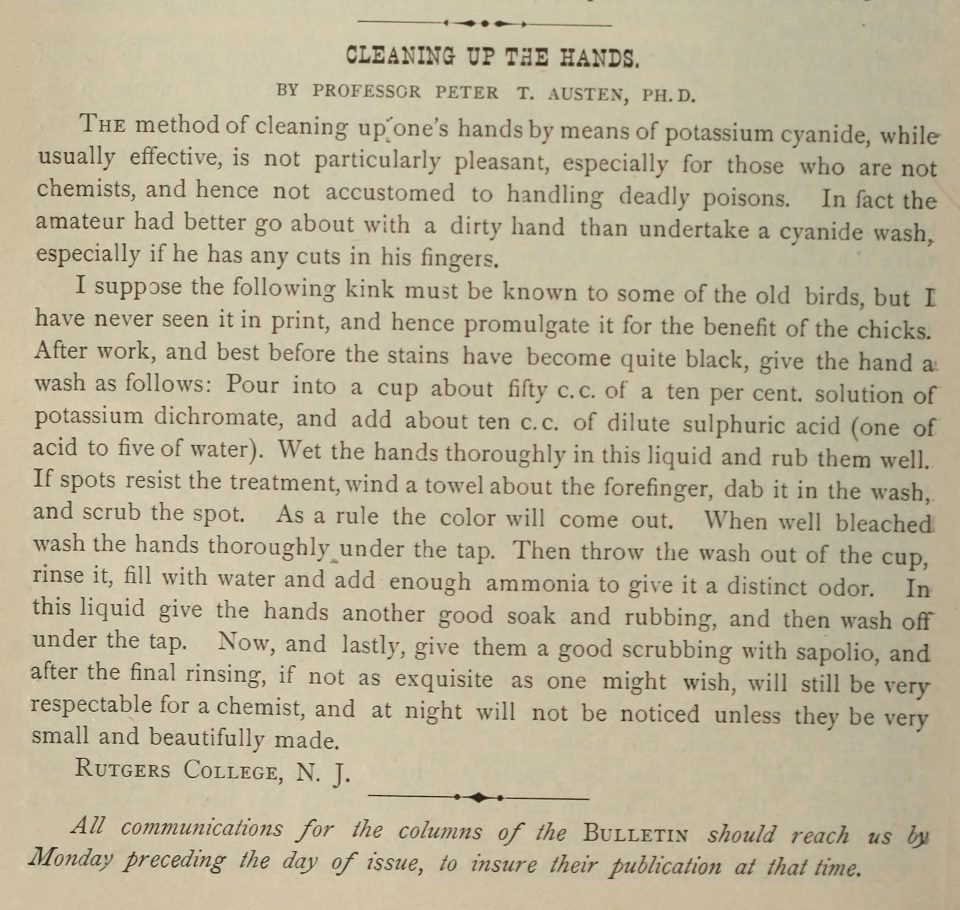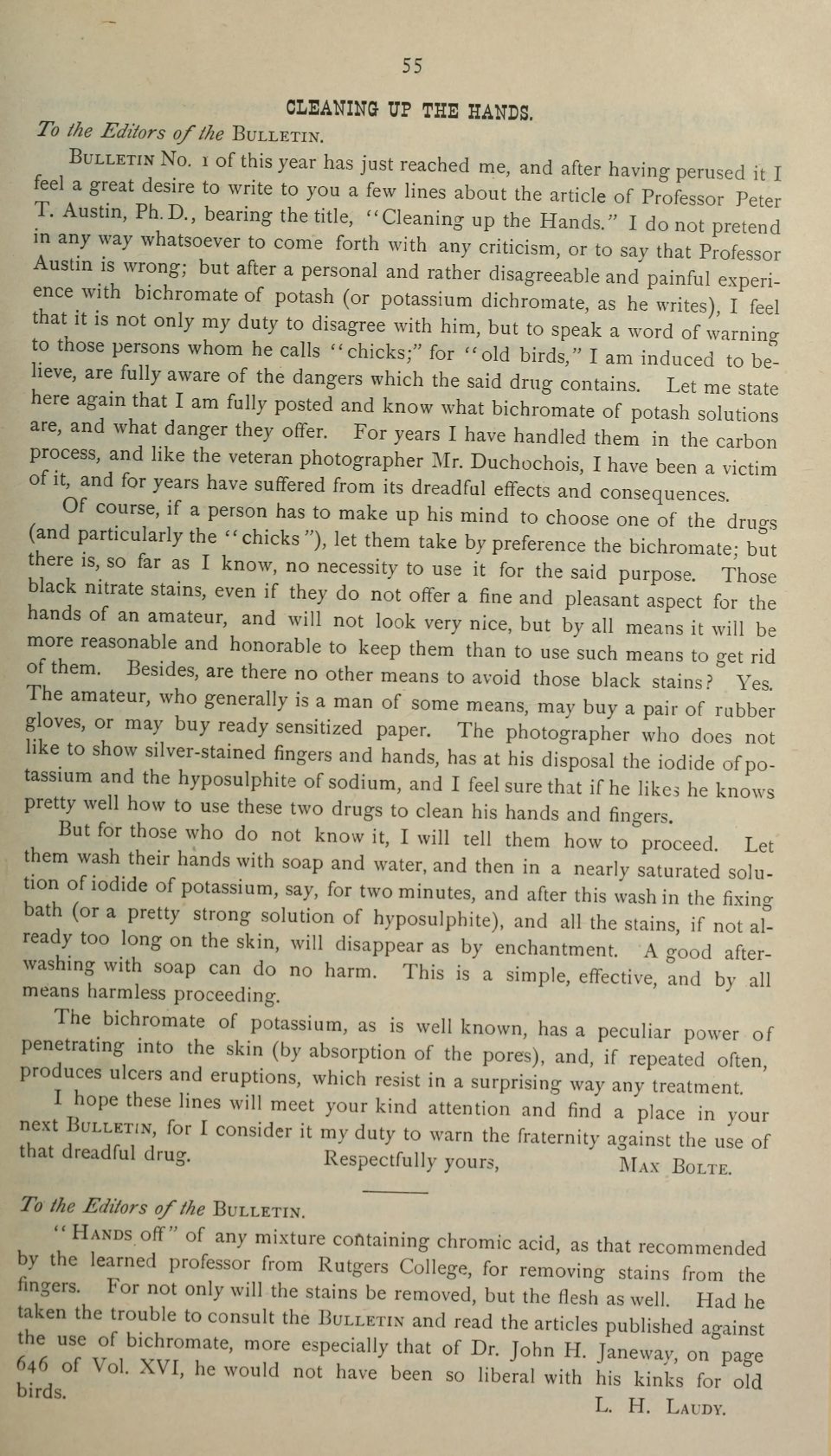In this episode of the Fine Art Photography Podcast, questionable advice on how to clean the black nitrate stains from the hands after darkroom work
Listen to this episode here:
Full transcript of Episode 78 of the Fine Art Photography Podcast
In this episode, questionable photography advice from 1888.
Of course in those days, much of the work was done in the darkroom. And much of it was done with really dangerous chemicals. Some of those chemicals are still used today, but others — wisely — are relegated to the past. Since many of these old magazines are written for amateurs, it’s rather terrifying to realize that a lot of people were using extremely dangerous solutions in their home darkrooms! And of course, working with light-sensitive solutions means that they had stained fingers too.
Case in point — I found an article in an 1888 issue of Anthony’s Photographic Bulletin called cleaning up the hands, written by Professor Peter T. Austen, PhD of Rutgers College, New Jersey.
Before I get into the content of the post by Professor Austen, let me also point out another thing I’ve realized from looking at these old journals.
In those days, there were a lot of these types of magazines targeted at photographers. Anthony’s Photographic Bulletin was published in New York by E. & H. T. Anthony & Co. from 1888. In those days, people read extensive texts that were dense with ideas but also a ton of chemistry. And they wrote in with responses. Today we make comments on social media — in the 1800s they wrote long letters to the editor which would be published in subsequent editions. Anthonys was published twice a month id you can believe that, and subscriptions cost $3.00 a year.
The issue at hand here is that working in the darkroom would leave the photographer with hands stained black — stains that wouldn’t wash off.
OK with that background, let me read you what Professor Austen of Rutgers advised. He uses some slang in this — he uses the terms “old birds” and “chicks” in reference to experienced photographers as opposed to newcomers to the practice.
I’m quoting verbatim here:
CLEANING UP THE HANDS.
BY PROFESSOR PETER T. AUSTEN, PH.D.The method of cleaning up one’s hands by means of potassium cyanide, while usually effective, is not particularly pleasant, especially for those who are not chemists, and hence not accustomed to handling deadly poisons. In fact the amateur had better go about with a dirty hand than undertake a cyanide wash, especially if he has any cuts in his fingers.
I suppose the following kink must be known to some of the old birds, but I have never seen it in print, and hence promulgate it for the benefit of the chicks. After work, and best before the stains have become quite black, give the hand a wash as follows: Pour into a cup about fifty c.c. of a ten percent solution of potassium dichromate, and add about ten c.c. of dilute sulphuric acid (one of acid to five of water). Wet the hands thoroughly in this liquid and rub them well. If spots resist the treatment, wind a towel about the forefinger, dab it in the wash, and scrub the spot. As a rule the color will come out.
When well bleached wash the hands thoroughly under the tap. Then throw the wash out of the cup, rinse it, fill with water and add enough ammonia to give it a distinct odor. In this liquid give the hands another good soak and rubbing, and then wash off under the tap. Now, and lastly, give them a good scrubbing with sapolio, and after the final rinsing, if not as exquisite as one might wish, will still be very respectable for a chemist, and at night will not be noticed unless they be very small and beautifully made.
Rutgers College, N. J.
In the following issue, a man named Max Bolte replied with this letter:
CLEANING UP THE HANDS.
To the Editors of the BULLETIN.BULLETIN No. I of this year has just reached me, and after having perused it I feel a great desire to write to you a few lines about the article of Professor Peter T. Austin, Ph. D., bearing the title, “Cleaning up the Hands.” I do not pretend in any way whatsoever to come forth with any criticism, or to say that Professor Austin is wrong; but after a personal and rather disagreeable and painful experience with bichromate of potash (or potassium dichromate, as he writes), I feel that it is not only my duty to disagree with him, but to speak a word of warning to those persons whom he calls “chicks” for “old birds,” I am induced to believe, are fully aware of the dangers which the said drug contains. Let me state here again that I am fully posted and know what bichromate of potash solutions are, and what danger they offer. For years I have handled them in the carbon process, and like the veteran photographer Mr. Duchochois, I have been a victim of it, and for years have suffered from its dreadful effects and consequences.
Of course, if a person has to make up his mind to choose one of the drugs (and particularly the “chicks”), let them take by preference the bichromate; but there is, so far as I know, no necessity to use it for the said purpose. Those black nitrate stains, even if they do not offer a fine and pleasant aspect for the hands of an amateur, and will not look very nice, but by all means, it will be more reasonable and honorable to keep them than to use such means to get rid of them.
Besides, are there no other means to avoid those black stains?
Yes.
The amateur, who generally is a man of some means, may buy a pair of rubber gloves, or may buy ready sensitized paper.
The photographer who does not like to show silver-stained fingers and hands, has at his disposal the iodide of potassium and the hyposulphite of sodium, and I feel sure that if he likes he knows pretty well how to use these two drugs to clean his hands and fingers. But for those who do not know it, I will tell them how to proceed.
Let them wash their hands with soap and water, and then in a nearly saturated solution of iodide of potassium, say, for two minutes, and after this wash in the fixing bath (or a pretty strong solution of hyposulphite), and all the stains, if not already too long on the skin, will disappear as by enchantment. A good after-washing with soap can do no harm. This is a simple, effective, and by all means harmless proceeding.
The bichromate of potassium, as is well known, has a peculiar power of penetrating into the skin (by absorption of the pores), and, if repeated often, produces ulcers and eruptions, which resist in a surprising way any treatment. I hope these lines will meet your kind attention and find a place in your next BULLETIN, for I consider it my duty to warn the fraternity against the use of that dreadful drug.
Respectfully yours,
Max Bolte.
Well I hope you enjoyed hearing these photographers from the past discussing issues facing them in their era. I don’t know about you, but it makes me appreciate how far we’ve come.
By the way — on the theme of what photographers struggled with then compared to now. Listen to these other topics of concern in 1888.
One writer complained about how composite photography was a sham and not really photography — another opined on the shortcomings of photography in relation to art, a headline that said “Who owns the negative?,” and still another discussed the best viewpoints for photographing the Yosemite Valley — this was two years before it became a National Park.
Frankly you could still see these topics discussed today.
Well, that’s all I’ve got for this episode.
Thanks for listening. I’ll talk to you again real soon.
Reproductions of the actual articles


Source
Anthony’s Photographic Bulletin, January 1888, accessed September 23, 2022, via The Internet Archive
